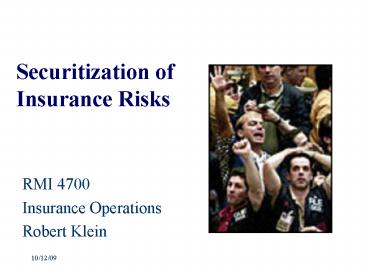Securitization of Insurance Risks - PowerPoint PPT Presentation
1 / 9
Title:
Securitization of Insurance Risks
Description:
Designed to use large capacity of financial markets to diversify risks where ... a small portion of a large risk reduces risk premium required, ample capacity. ... – PowerPoint PPT presentation
Number of Views:62
Avg rating:3.0/5.0
Title: Securitization of Insurance Risks
1
Securitization of Insurance Risks
- RMI 4700
- Insurance Operations
- Robert Klein
2
Securitization of Liabilities
- Involves creating a financial instrument (e.g.,
cat bond) that effectively diversifies or hedges
a primary insurers underwriting risk. - Designed to use large capacity of financial
markets to diversify risks where conventional
reinsurance is less efficient and/or capacity
constrained. - Some risks more suitable for securitization than
others. - Catastrophe options and bonds have been primary
instruments.
3
Catastrophe Call Option Spread
- CBOT exchange-traded contracts that settle on
loss indices developed by PCS. - Index (x a) 100 M 1 point
- Example 20/40 call spread
- If event caused 30B in losses, each contract
would pay 2,000 (100 points x 20).
0 for x lt a (x a) for a ltx ltb (b
a) for x gt b
b
f(x)
f(x)
x industry losses
a
B
20
40
4
Limited Volume of Cat Options Traded
5
Catastrophe Bond
- Insurer issues bonds with interest equal to
risk-free rate risk premium 350-600 basis
points (for 1 probability loss). - Investors receive principal plus interest if no
event. - All or portion of interest and principal forgiven
if event occurs.
6
Typical Structure of Catastrophe Bond with
Special Purpose Reinsurer
Insurer
Principal and/or Interest given a trigger event
Premium Payment
Single Purpose Reinsurer
Contingent Principal and/or Interest payment
Principal
Investors
7
Moral Hazard vs. Basis Risk
- Basis risk refers to disconnect between payout
on contract ceding insurers losses. - Tying payout to ceding insurers losses raises
moral hazard risk.
- Non-Parametric Triggers
- Tied to cedant loss
- Lowers basis risk, but increases moral hazard.
- Parametric Triggers
- Not tied to cedant loss
- Based on physical event, e.g., storm or
earthquake intensity. - Or, total industry losses.
- Depending on trigger, high basis risk potential.
- Dual Triggers
- Parametric Non-Parametric
8
Reinsurance vs. Securitization
- Reinsurance
- Basis risk tends to be minimized to extent treaty
based on losses of ceding insurer. - Moral hazard has to be controlled through
contract terms and monitoring by reinsurer. - Tail risk easier to handle in reinsurance.
- Reinsurer provides other services, e.g., risk
assessment. - But, capacity constrained for catastrophes high
risk premium. - Securitization
- Each investor can efficiently take a small
portion of a large risk ? reduces risk premium
required, ample capacity. - Basis risk vs. moral hazard addressed through
triggers and other devices.
9
Issues in Future of Securitization
- Insurer demand
- Investor knowledge and acceptance.
- Transaction costs.
- Regulatory treatment.
- Most securitizations have been done offshore to
avoid taxes. - NAIC adopted model legislation that would
facilitate onshore SPRVs Protected Cells. - Some reinsurers fighting onshore SPRVs and
proposal for favorable tax treatment. - It will take time for securitization vehicles to
be refined and market to develop.































